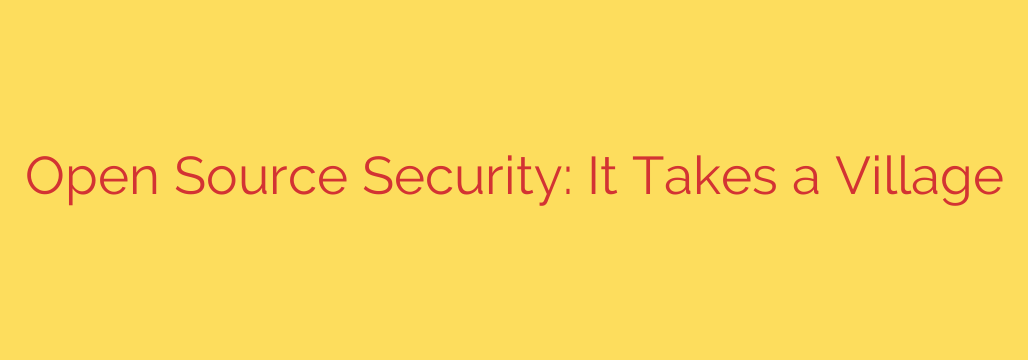
Open Source Security: Why We’re All Responsible for a Safer Digital World
Open-source software (OSS) is the invisible foundation of our digital lives. It powers everything from the apps on your phone and the servers in the cloud to the smart devices in your home. This collaborative, community-driven approach to software development has fueled unprecedented innovation, allowing companies to build better products faster and more efficiently.
But this reliance comes with a critical challenge: security. When the very code that underpins our digital infrastructure is vulnerable, the consequences can be catastrophic. The traditional belief that “many eyes” on open code make all bugs shallow has been proven to be a dangerous oversimplification. The reality is that while some high-profile projects receive ample attention, many essential components are maintained by a small handful of overworked, often unpaid, volunteers.
A vulnerability in a single, obscure open-source component can create a security crisis on a global scale. We saw this with the Log4Shell incident, where a flaw in a widely used Java logging library sent shockwaves through the tech industry, forcing a massive, frantic effort to patch systems worldwide. This was a wake-up call, making it clear that we can no longer afford to be passive consumers of open-source code.
Securing the open-source ecosystem is not just one person’s job; it is a shared responsibility that requires a collective effort from everyone involved.
The Shared Responsibility Framework
True security requires a new model where every participant in the software supply chain plays an active role. This collaborative defense involves several key groups:
- Maintainers and Developers: As the creators and frontline defenders, maintainers need more than just goodwill. They need resources, training in secure coding practices, and better tools to help them identify and fix vulnerabilities before they are ever published. Empowering maintainers with security tools and education is the first line of defense.
- Corporations and Enterprises: As the largest consumers and beneficiaries of OSS, corporations have a profound responsibility to contribute back. Simply using free software without investment is unsustainable. This contribution can take many forms: funding projects directly, dedicating employee time to contribute code and patches, or providing security expertise and audits. Companies must transition from being passive consumers to active stakeholders in the health of the projects they depend on.
- Security Researchers: These individuals and teams are the digital watchdogs of the ecosystem. Their work in discovering, analyzing, and responsibly disclosing vulnerabilities is invaluable. A healthy, transparent, and respectful relationship between researchers and maintainers is crucial for quickly and effectively addressing security flaws.
- Foundations and Alliances: Organizations like the Open Source Security Foundation (OpenSSF) and the Linux Foundation play a vital role as coordinators. They provide a neutral ground for companies, developers, and researchers to collaborate, pool resources, develop industry-wide standards, and fund critical security initiatives that no single entity could tackle alone.
Actionable Steps for a More Secure Software Supply Chain
Moving from theory to practice is essential. Here are concrete steps your organization can take to become a responsible steward of the open-source ecosystem:
Know Your Code: The Power of an SBOM
You cannot secure what you do not know you are using. A Software Bill of Materials (SBOM) is an inventory of every open-source component and dependency within your applications. Creating and maintaining an SBOM is the foundational step for any serious security program, allowing you to quickly identify if you are affected when a new vulnerability is discovered.Automate Your Defenses: Implement Vulnerability Scanning
Manually tracking vulnerabilities is impossible at scale. Implement Software Composition Analysis (SCA) tools to automatically scan your dependencies for known vulnerabilities. Integrating these tools into your development pipeline provides developers with immediate feedback, helping to catch security issues long before they reach production.Give Back: Contribute and Fund
Identify the critical open-source projects your business relies on and find a way to contribute. This could be through direct financial sponsorship, allowing your developers to contribute code on company time, or helping improve documentation. Investing in these projects is a direct investment in the stability and security of your own products.Adopt Secure Development Practices
Security begins at home. Train your development teams in secure coding practices and foster a culture where security is seen as a shared responsibility, not an afterthought. This internal strength reduces the risk of introducing new vulnerabilities into the ecosystem.
The security of our interconnected world is built on open source. It’s time we all started acting like its custodians. By working together—developers, corporations, and security experts—we can build a more resilient, secure, and trustworthy digital future for everyone.
Source: https://go.theregister.com/feed/www.theregister.com/2025/07/22/open_source_windows_security_opinion_column/








